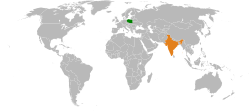
Poland and Lithuania established diplomatic relations from the 13th century, after the Grand Duchy of Lithuania under Mindaugas acquired some of the territory of Rus' and thus established a border with the then-fragmented Kingdom of Poland. Polish–Lithuanian relations subsequently improved, ultimately leading to a personal union between the two states. From the mid-16th to the late-18th century Poland and Lithuania merged to form the Polish–Lithuanian Commonwealth, a state that was dissolved following their partition by Austria, Prussia and Russia. After the two states regained independence following the First World War, Polish–Lithuanian relations steadily worsened due to rising nationalist sentiments. Competing claims to the Vilnius region led to armed conflict and deteriorating relations in the interwar period. During the Second World War Polish and Lithuanian territories were occupied by both the Soviet Union and Nazi Germany, but relations between Poles and Lithuanians remained hostile. Following the end of World War II, both Poland and Lithuania found themselves in the Eastern Bloc, Poland as a Soviet satellite state, Lithuania as a Soviet republic. With the fall of communism relations between the two countries were reestablished. Since then relations have been friendly and akin to strategic partnership in defence and security.
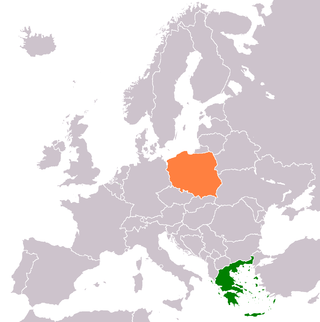
Greek-Polish relations are relations between Greece and Poland. Both countries are full members of NATO, the European Union, Three Seas Initiative, OECD, OSCE, the Council of Europe and the World Trade Organization. There are circa 4,000 people of Greek descent living in Poland, and over 20,000 people of Polish descent living in Greece. Greece has given full support to Poland's membership in the European Union and NATO.

Poland–Ukraine relations revived on an international basis soon after Ukraine gained independence from the Soviet Union in 1991. Various controversies from the shared history of the two countries' peoples occasionally resurface in Polish–Ukrainian relations, but they tend not to have a major influence on the bilateral relations of Poland and Ukraine.

Poland–Russia relations have a long and often turbulent history, dating to the late Middle Ages. Over centuries, there have been several Polish–Russian Wars, with Poland once occupying Moscow and later Russia controlling much of Poland in the 19th as well as in the 20th century, leading to strained relations and multiple Polish attempts at re-acquiring independence. Polish–Russian relations entered a new phase following the fall of communism, with relations warming under Soviet Premier Mikhail Gorbachev and later Russian President Boris Yeltsin. Relations began worsening considerably as a result of the 2008 Russian invasion of Georgia, and later the 2014 annexation of Crimea and especially the 2022 Russian invasion of Ukraine. Relations between the Polish and Russian governments have become extremely unfriendly, and according to a 2022 poll, only 2% of Poles view Russia positively, the lowest number in the world among countries polled.
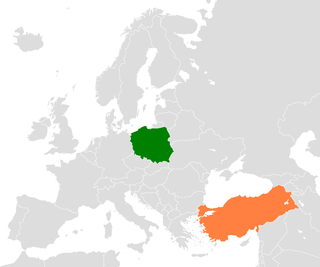
Polish–Turkish relations are the foreign relations between Poland and Turkey. Both countries are full members of NATO, OECD, OSCE, the Union for the Mediterranean, the Council of Europe and the World Trade Organisation. Poland is a member of the European Union, Turkey is not a member.

Denmark–Poland relations refers to the bilateral relations between Denmark and Poland. Relations between the two countries date back to the Middle Ages, while modern diplomatic relations were established on 8 September 1919. During the 20th century, relations were turbulent but amicable. The two countries moreover maintained a maritime border dispute until 2018 when it was delineated.

Polish–Romanian relations are foreign relations between Poland and Romania.
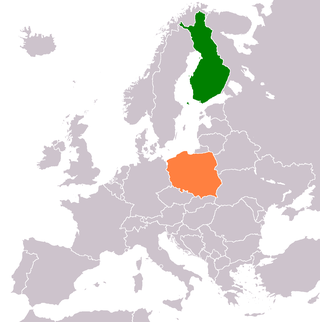
Finland–Poland relations refer to bilateral relations of Finland and Poland. Both countries are members of the European Union, NATO, OECD, OSCE, Council of the Baltic Sea States, HELCOM, Council of Europe and the World Trade Organization. Both countries established diplomatic relations on 8 March 1919. Finland strongly supported Poland's the European Union membership during the latter's accession process. Poland strongly supported Finland's NATO membership during the latter's accession process.

Austria–Poland relations are foreign relations between Austria and Poland. The two nations have a very long historical relationship dating back several centuries, which has been complicated throughout most of their history.

Pakistan–Poland relations are the bilateral relations between Poland and Pakistan, which date back to the 1940s. After the Independence of Pakistan on August 14, 1947, Liaquat Ali Khan, the first Prime minister of Pakistan, made the first diplomatic approaches to the People's Republic of Poland and finally, on December 17, 1962, Pakistan became one of the first Muslim countries to establish relations with then-communist government of Poland.
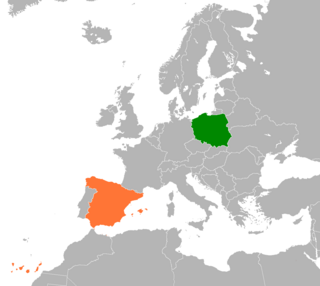
Poland–Spain relations are cultural and political relations between Poland and Spain. Both nations are members of NATO, the European Union, OECD, OSCE, the Council of Europe and the United Nations. Spain has given full support to Poland's membership in the European Union and NATO.

Diplomatic relations exist between Australia and Poland. Over 170,000 Australian citizens are of Polish descent. Both nations are members of the Australia Group and the Organisation for Economic Co-operation and Development.

Japan–Poland relations refers to the bilateral foreign relations between Japan and Poland. Both nations enjoy historically friendly relations, embracing close cooperation and mutual assistance in times of need. Both are members of the OECD, World Trade Organization and United Nations.

Iran–Poland relations are historical and bilateral relationship between the Islamic Republic of Iran and the Republic of Poland. Both nations are members of the United Nations.

Algeria and Poland are members of the Union for the Mediterranean and the United Nations. Both nations established diplomatic relations in 1962.
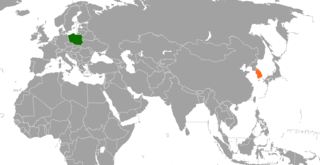
Poland–South Korea relations is the diplomatic relationship between the Republic of Poland and Republic of Korea.

Poland–Tanzania relations are the diplomatic relations between the Republic of Poland and the United Republic of Tanzania. Both nations are members of the United Nations and the World Trade Organization.

Norway–Poland relations are the diplomatic relations between the Kingdom of Norway and the Republic of Poland. Both nations enjoy friendly relations, the importance of which centers on mutual historical relations and the fact that more than 100,000 Polish citizens live in Norway on a permanent basis, Poles make up 2.10% of the Norwegian population. Both nations are members of the Council of Europe, Council of the Baltic Sea States, NATO, OECD, OSCE, United Nations and the World Trade Organization.

Poland–Portugal relations are the bilateral relations between the Republic of Poland and the Portuguese Republic. Both nations are members of the Council of Europe, European Union, NATO and the United Nations.

Morocco–Poland relations are bilateral relations between Morocco and Poland. Both nations are full members of the World Trade Organization, the Union for the Mediterranean and the United Nations.
